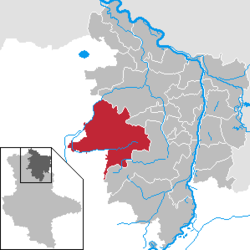Bismark, Germany
| Bismark | ||
|---|---|---|
|
||
| Coordinates: 52°40′0″N 11°33′0″E / 52.66667°N 11.55000°ECoordinates: 52°40′0″N 11°33′0″E / 52.66667°N 11.55000°E | ||
| Country | Germany | |
| State | Saxony-Anhalt | |
| District | Stendal | |
| Government | ||
| • Mayor | Gudrun Wolter | |
| Area | ||
| • Total | 289.43 km2 (111.75 sq mi) | |
| Population (2015-12-31) | ||
| • Total | 8,418 | |
| • Density | 29/km2 (75/sq mi) | |
| Time zone | CET/CEST (UTC+1/+2) | |
| Postal codes | 39576, 39579, 39599, 39606, 39624, 39629 | |
| Dialling codes | 039080, 039083, 039089, 039320, 039324, 039325, 039328 | |
| Vehicle registration | SDL | |
| Website | www.stadt-bismark.de | |
Bismark is a town in the Stendal district, in the historic Altmark region, of northern Saxony-Anhalt, Germany. It is situated approximately 22 km (14 mi) west of Stendal in Northern Germany.
In the early 12th century the area then under the rule of Albert the Bear was settled with peasants migrating from the Low Countries. The town's name is derived from the nearby Biese creek (after Dutch: bies meaning rush plants), a tributary of the Aland; though it may also refer to the bishop's march, a possession of the Havelberg bishops mentioned in a 1209 deed issued by the Ascanian margrave Albert II. With the Altmark, Bismark was part of the Margraviate of Brandenburg until it was adjudicated to the Prussian Province of Saxony after the 1815 Congress of Vienna.
One Herbordus of Bismarck was mentioned holding the office of a Schultheiß in Stendal about 1270. His descendant Otto von Bismarck received the honorary citizenship of Bismark in 1895.
Upon an administrative reform effective from 1 January 2010, the town of Bismark comprises the former municipalities of Badingen, Berkau, Büste, Dobberkau, Garlipp, Grassau, Hohenwulsch, Holzhausen, Käthen, Kläden, Könnigde, Kremkau, Meßdorf, Querstedt, Schäplitz, Schernikau, Schorstedt and Steinfeld.
...
Wikipedia



